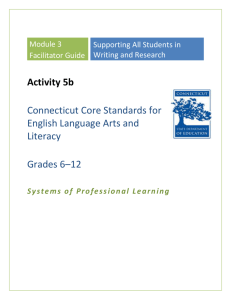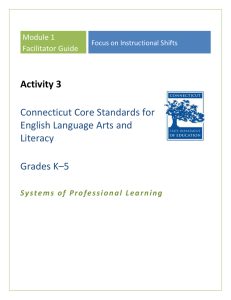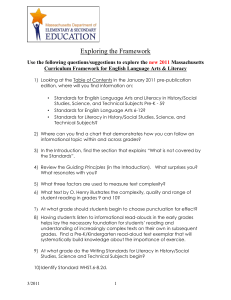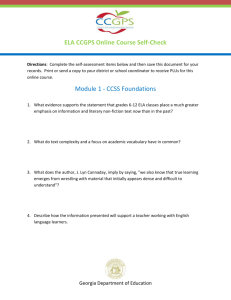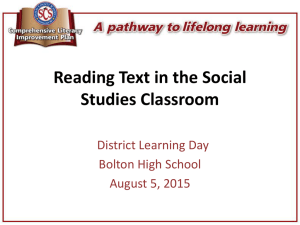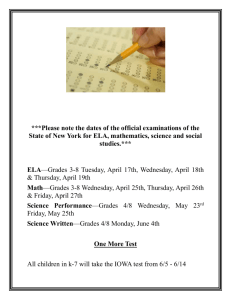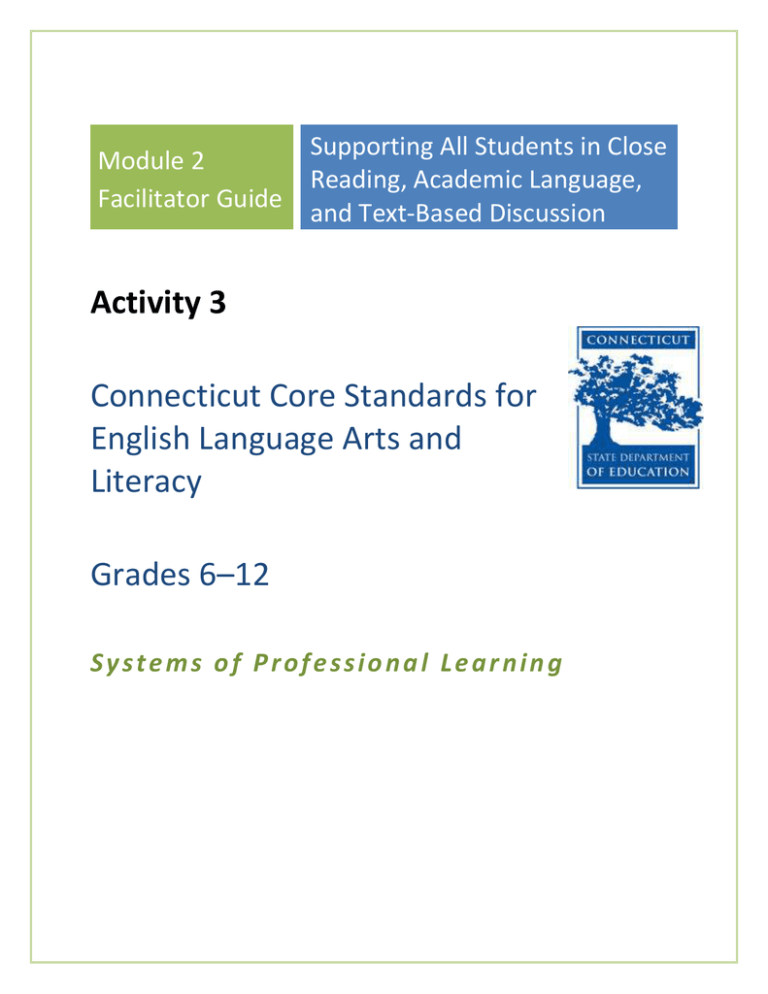
Module 2
Facilitator Guide
Supporting All Students in Close
Reading, Academic Language,
and Text-Based Discussion
Activity 3
Connecticut Core Standards for
English Language Arts and
Literacy
Grades 6–12
Systems of Professional Learning
Module 2 Participant Guide
Connecticut Core Standards for ELA & Literacy
Grades 6–12: Supporting All Students in Close Reading,
Academic Language, and Text-based Discussion
Connecticut Core Standards Systems of Professional Learning
The material in this guide was developed by Public Consulting Group in collaboration with staff from the Connecticut State
Department of Education and the RESC Alliance. The development team would like to specifically thank Ellen Cohn,
Charlene Tate Nichols, and Jennifer Webb from the Connecticut State Department of Education; Leslie Abbatiello from
ACES; and Robb Geier, Elizabeth O’Toole, and Cheryl Liebling from Public Consulting Group.
The Systems of Professional Learning project includes a series of professional learning experiences for Connecticut Core
Standards District Coaches in English Language Arts, Mathematics, Humanities, Science, Technology, Engineering,
Mathematics (STEM), and Student/Educator Support Staff (SESS).
Participants will have continued support for the implementation of the new standards through virtual networking
opportunities and online resources to support the training of educators throughout the state of Connecticut.
Instrumental in the design and development of the Systems of Professional Learning materials from PCG were: Sharon
DeCarlo, Debra Berlin, Jennifer McGregor, Judy Buck, Michelle Wade, Nora Kelley, Diane Stump, and Melissa Pierce.
Excerpts, tools, and strategies from Thinkquiry Toolkit 1 © 2011 and Thinkquiry Toolkit 2 © 2014. All rights reserved.
Used with permission of Public Consulting Group. Excerpts from PCG Education White Papers Universal Design for
Learning © 2013 and Making a Difference in Student Achievement © 2011. All rights reserved. Used with permission of
Public Consulting Group.
Published 2014. Available online at http://ctcorestandards.org/
Connecticut Core Standards for ELA & Literacy
Grades 6–12: Supporting All Students in Close Reading,
Academic Language, and Text-Based Discussion
Module 2 Facilitator Guide
Session at-a-Glance
Activity 3a and 3b: Digging Deeply –Close Reading, Text-Dependent Questions, and
Academic Language (60 minutes)
Participants choose and read an appropriately complex (may be read aloud) text, noting the central idea of the
text, content knowledge, and academic language and vocabulary challenges in the text. Concentrating on the
vocabulary they select, they divide the words into quadrants for instruction using a graphic organizer.
Supporting Documents:
Text Excerpts in the Appendix of the Participant Guide
Directions
Close Reading Organizer
Academic Vocabulary Organizer
PowerPoint Slides:
32–47
Session Implementation
Title slide
1
Connecticut Core Standards for ELA & Literacy
Grades 6–12: Supporting All Students in Close Reading,
Academic Language, and Text-Based Discussion
Module 2 Facilitator Guide
Slide 32
Blank.
Slide 33
(100 minutes) In Part 3, participants will learn more about specific elements of close reading and will practice
those elements.
Building on Module 1, participants come to a deeper understanding of the relationship of academic language to
close reading. They review the sequencing of text-dependent questions introduced in Module 1. They will learn
more about types and purposes of text-dependent questions, including questions for general understanding, key
details and inferences, academic language, craft and structure, and to discern author’s purpose. They begin to
build a close reading lesson by selecting and reading a short text.
Slide 34
2
Connecticut Core Standards for ELA & Literacy
Grades 6–12: Supporting All Students in Close Reading,
Academic Language, and Text-Based Discussion
Module 2 Facilitator Guide
Remind participants of these two bookend standards for reading. While all of the reading standards require
reading closely, these two summarize both the purpose and the requirement for close reading.
Slide 35
The purpose of this slide is to explain how close reading relates to the 3 instructional shifts introduced in Module
1.
• The practice of close reading is a way in which readers are able to address all of the shifts.
• We read closely to build knowledge from text;
• we find evidence by reading text closely;
• and close reading is a way to scaffold students toward independence in reading complex text and building
vocabulary and language skills.
• In order for teachers to scaffold students toward independently reading and comprehending complex text,
teachers must first read the text themselves.
• Teachers read the text thoroughly, identify big ideas and key details in the text, determine the organizing
structure of the text, and identify potential barriers in terms of vocabulary and academic language.
• Text-dependent questions serve as models for the kinds of questions good readers ask themselves.
Slide 36
The purpose of this slide is to provide a context for WHY close reading has become a symbol of CCSS. Like the
shifts, it is really how literacy instruction in the CCSS differs from previous practice and it is a key to reading
success and college readiness.
Talk and Turn to your partner: What have been some struggles using close reading of complex text; what have
been some successes?
3
Connecticut Core Standards for ELA & Literacy
Grades 6–12: Supporting All Students in Close Reading,
Academic Language, and Text-Based Discussion
Module 2 Facilitator Guide
Slide 37
Remind participants that they saw this slide in Module 1. Let them know that we will be practicing creating textdependent questions today. Remind them of the two big steps in creating text-dependent questions (Phase 1 and
Phase 2).
Activity 3a
Slide 38
Direct participants to choose a text that they will continue to use throughout the remainder of the day’s
activities. They may choose from the following:
• One that you brought with you today, or
• One of the selections from the Appendix of the Participant Guide
Direct participants to the appropriate page in their Participant Guide and review the 3 column Close Reading
Organizer.
4
Connecticut Core Standards for ELA & Literacy
Grades 6–12: Supporting All Students in Close Reading,
Academic Language, and Text-Based Discussion
Module 2 Facilitator Guide
Slide 39
Explain that now they have identified core content, challenging parts of the text, and key vocabulary, we are going
to dig a little more deeply into the choice and treatment of vocabulary.
These college and career ready anchor standards relate to vocabulary.
CCSS.ELA-Literacy.CCRA.L.3
Apply knowledge of language to understand how language functions in different contexts, to make effective
choices for meaning or style, and to comprehend more fully when reading or listening.
CCSS.ELA-Literacy.CCRA.L.4
Determine or clarify the meaning of unknown and multiple-meaning words and phrases by using context clues,
analyzing meaningful word parts, and consulting general and specialized reference materials, as appropriate.
CCSS.ELA-Literacy.CCRA.L.5
Demonstrate understanding of figurative language, word relationships, and nuances in word meanings.
CCSS.ELA-Literacy.CCRA.L.6
Acquire and use accurately a range of general academic and domain-specific words and phrases sufficient for
reading, writing, speaking, and listening at the college and career readiness level; demonstrate independence in
gathering vocabulary knowledge when encountering an unknown term important to comprehension or
expression.
Slide 40
• Remind participants that in Module 1, we learned about the 3 tiers of vocabulary, and that both tiers 2
and 3 were important to teach.
5
Connecticut Core Standards for ELA & Literacy
Grades 6–12: Supporting All Students in Close Reading,
Academic Language, and Text-Based Discussion
Module 2 Facilitator Guide
•
We also discussed that Tier 2 words are often overlooked in instruction because they are not domain
specific, nor easily defined. Yet they are important for instruction because they carry meaning of the
text and help carry content.
• Ask participants to look at the vocabulary words they chose for their close reading lesson. Consider
whether the words are general academic words (Tier 2) or domain specific (Tier 3).
(Found in Appendix A. Tiers are credited to Beck, I. L., McKeown, M. G., & Kucan, L. (2008). Creating robust
vocabulary: Frequently asked questions and extended examples. New York, NY: Guilford.)
Slide 41
The purpose of this slide is to differentiate academic language from vocabulary.
• We often hear the terms Academic Vocabulary and Academic Language used interchangeably.
• Academic language is more than just the unfamiliar vocabulary that students encounter in their content area
classes, or the texts that they are required to read.
• While academic vocabulary is a component of academic language, there are other aspects of the language of
school that are crucial predictors for academic success–some of which are not easily defined.
Read the examples, below:
Information “packing”: As we learn more precise words and structures, we are able to express complex ideas in
shorter ways. E.g., “Water being turned into steam by heat and then going into the air,” becomes “evaporation.”
A feature of academic texts is that more information is compacted into fewer words. It is dense language.
Linking ideas (pronoun reference, connectors): More complex texts use pronoun references, or shift the words
used to refer to the same person or thing within a text, e.g. “she”/”Mary”, or calling a cruel king “the tyrant” in
another part of the text. Also, more complex texts use connectors that may be unfamiliar to students, for
example, “however,” “therefore,” or “consequently.”
Structure of discourse: Different kinds of text are structured differently, and students may not understand the
text because they don’t understand the structure. For example, the structure of an argumentative text is different
than that of a narrative. Texts are organized differently in different domains as well.
Level of formality: Academic language, in general, is more formal than everyday speech. In addition, different
types of contexts require different kinds of speech. Students need to be able to recognize this within texts so that
they are better able to understand what they are reading. Is this a business proposal? Or is it a dialogue in
everyday informal language? This extends to writing as well, so that students understand that the level of
formality must match the audience, purpose, and occasion.
(SERP = Strategic Education Research Partnership: SERP is designed to provide the infrastructure to make a
coherent and sustained research, development, and implementation program possible.)
6
Connecticut Core Standards for ELA & Literacy
Grades 6–12: Supporting All Students in Close Reading,
Academic Language, and Text-Based Discussion
Module 2 Facilitator Guide
Slide 42
Have pairs determine the academic language in this brief essay. Participants discuss and highlight the words and
phrases that helps to make this an example of academic language and less common or informal language. They
can find the excerpt on Page 17 of the Participant Guide The extract is taken from Darwin's book The Voyage of
the Beagle. In the book he describes his voyage around the world as a ship's naturalist. On this voyage he gathered
evidence that was to lead him to put forward his Theory of Evolution.
Slide 43
The phrases in red are those that are used to reflect the expectations of academic English.
Slide 44
7
Connecticut Core Standards for ELA & Literacy
Grades 6–12: Supporting All Students in Close Reading,
Academic Language, and Text-Based Discussion
Module 2 Facilitator Guide
Differences between informal language and academic language - Informal language, for example, typically relies
on more basic discourse structures, such as narratives, while the use of academic language often requires the use
of specific linguistic functions, such as persuading, hypothesizing, reporting facts or findings, or presenting an
argument. Informal language makes more extensive use of oral communication – listening and speaking with
everyday language – while academic language is commonly used in more “formal” settings that require more
extensive use of reading and writing skills. It can also be argued that informal language is often relatively
contextualized, or used within a context that the speaker and listener are familiar with and a part of, whereas
academic language is relatively decontextualized and therefore more cognitively demanding.
Adapted from: Robin Scarcella, Academic Language: A Conceptual Framework
A Technical Report, University California, Irvine, 2003
Slide 45
The purpose of this slide is to remind participants of how we choose and prioritize vocabulary for instruction
within and beyond a text-based lesson.
Remind participants that, as they are choosing vocabulary for TDQ’s, they should also be attending to other
academic language challenges that will likely interfere with students’ comprehending the text at hand.
Slide 46
The purpose of this slide is to introduce the vocabulary quadrant activity.
Vocabulary Quadrant: http://achievethecore.org/content
This vocabulary quadrant is helpful for making decisions about how to treat the vocabulary we have identified.
Help participants locate the excerpt from, “Living Like Weasels” in their Participant Guide. They do not need to
read it – only to have it available.
8
Connecticut Core Standards for ELA & Literacy
Grades 6–12: Supporting All Students in Close Reading,
Academic Language, and Text-Based Discussion
Module 2 Facilitator Guide
Explain how and why these words were chosen.
• are Tier 3 words in this text. They are important to understanding the setting, but will not continue in
importance throughout the text.
• are all Tier 2 words. They can be used in a word sort or on a word wall, and they are closely related.
• Tyrannical also fits into this category, but it would be hard to define in context.
• “lap of lichen,” is an example of academic language (“lap” is idiomatic). However, it is also something
students would not encounter again, and for that reason was not included in column 2 as meriting more time
and attention.
Ultimately, if the list gets too long, the teacher may just decide to define the words in column 1 and move on.
In Activity 3b, participants will try this activity with their own close reading selection.
Activity 3b
Slide 47
Directions for this activity are in the Participant Guide. Participants will use the vocabulary they selected for their
close reading lesson and, using the vocabulary quadrant, make decisions about how that vocabulary might be
treated in the lesson and beyond.
9

